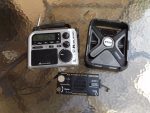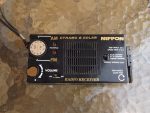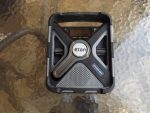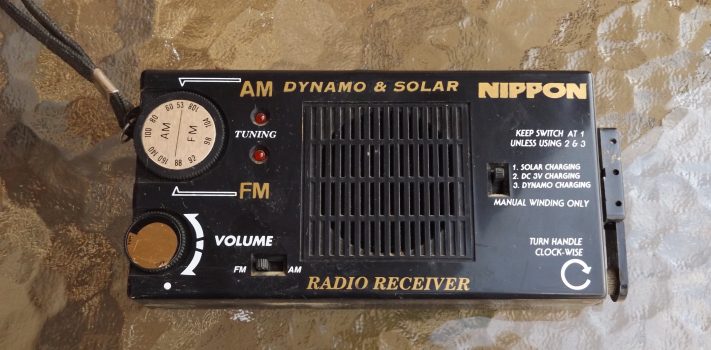Today, I’m describing some of my experiences with compact survival radios: Both the good and the useless.
To start, I should mention that I don’t have a landline home phone any longer – just a phone line for my Internet service. I’m fine with that, because 95% of the calls I got on my home phone were people trying to scam me or sell me something. So, I don’t miss a hone phone line. When I was 25-years old, I lived for the phone, because l was dating three girls – all named Cindy. (True!)
My wife and I both have cell phones, and to tell you the truth, I could live without mine. Once again, lots of calls from telemarketers, and people trying to sell me something – so I can live without the cell phone, if I don’t know who’s calling me, I don’t answer it any longer – if it is important, the caller will leave a voice mail for me.
Our big screen television is on several hours a day, but it is in the living room, not my office. I have it on for some background noise, other than my German Shepherds barking when the UPS driver goes by, or when a driveway alert goes off. I rarely watch (or listen) the mainstream “news” on the television – they all read from the same script these days. In my pickup truck, I have a stationed that plays a lot of “Oldies” music – from the mid-1960s onward. Personally, I believe the best music ever was from the mid-1960s to the early 1970s, but that’s just me and my generation. We have two Christian radio stations in our area, and I tune into them once in a while, but their playlist is very limited – get tired of hearing the same 40 or 50 songs all the time.
Communications are important if you are a Prepper – you need to know what is going on in the world, in your state and your community. Of course, we can get some second-hand information from our friends on the cell phone – but it is usually unreliable or exaggerated when we hear it. So, I tune in to the radio, or the Internet for the real news. Communications come in several forms, for most people it is the cell phone, however we really need to have radios to stay on top of the news.
We’ve all seen comapct “survival” radios, and these have been around for quite some time – they usually have AM and FM bands. However, many today have a weather alert system, that I find we all can benefit from. It’s a good idea to know if a bad weather front is coming our way – it can make the difference between life and death – do I bug out or stay bugged in when the weather turns bad. Good to know this stuff – if a tornado is coming your way, it’s probably not a good idea to jump into your truck and hook-up your travel trailer – you might just get blown away to Oz.
 Of you want a serious survival radio, you need one that operates off of batteries, solar power or wind-up power. Of course, as already mentioned, you need an AM/FM reception and a weather channel is fantastic. If you can find one with an extra shortwave band, then snap it up. You’ll be surprised by the news you can hear from the BBC (British Broadcasting Company) about events in the US that you don’t near locally or nationally – but you should know about. The BBC is really on top of events happening in the USA.
Of you want a serious survival radio, you need one that operates off of batteries, solar power or wind-up power. Of course, as already mentioned, you need an AM/FM reception and a weather channel is fantastic. If you can find one with an extra shortwave band, then snap it up. You’ll be surprised by the news you can hear from the BBC (British Broadcasting Company) about events in the US that you don’t near locally or nationally – but you should know about. The BBC is really on top of events happening in the USA.
Some survival radios also have lights on them. However, when you use them, you really use-up your battery power, so use those lights as little as possible. Also, having an external radio antenna on these radios helps pull in distant stations. Some radios have external antenna and ground terminals and some do not. So look for those, before you buy.
Don’t Buy Junk
 I first want to issue a warning on the ubiquitous “Nippon” survival radios. These have been around for 30 years. The provide AM/FM radio reception and have a solar panel on the top, and a crank on the side, so you can crank it and charge-up the battery inside of it. I’ve seen these radios advertised all over the place in survival-type magazines for years – one was American Survival Guide, and I wrote for them for a good many years, until they got politically correct. Let me make this really clear: do NOT buy these radios. They are junk – I’ve owned a number of them, and it would be hard to tune in a radio station if they operated next to your house – terrible reception. The solar panel on top – don’t think they ever worked. Worst of all, the hand cranks on the side break off in short order, and when they briefly did work, if you cranked it for 20-mins – you might get 30 mins of radio reception from all your hard work. These radios still sell for $19.99. But they aren’t even worth the shipping.
I first want to issue a warning on the ubiquitous “Nippon” survival radios. These have been around for 30 years. The provide AM/FM radio reception and have a solar panel on the top, and a crank on the side, so you can crank it and charge-up the battery inside of it. I’ve seen these radios advertised all over the place in survival-type magazines for years – one was American Survival Guide, and I wrote for them for a good many years, until they got politically correct. Let me make this really clear: do NOT buy these radios. They are junk – I’ve owned a number of them, and it would be hard to tune in a radio station if they operated next to your house – terrible reception. The solar panel on top – don’t think they ever worked. Worst of all, the hand cranks on the side break off in short order, and when they briefly did work, if you cranked it for 20-mins – you might get 30 mins of radio reception from all your hard work. These radios still sell for $19.99. But they aren’t even worth the shipping.
Better Quality, From Midland
 I have a pretty decent survival radio from the local small box store, and it’s made by Midland – on-sale they are usually $29.97 – and well worth the money. This radio has the AM/FM as well as the weather alert – several different stations. (Midland also makes dedicated weather alert radios.) The Midland brand compact radios seem to change case designs often, but I suspect that their internals don’t change much. Their latest model is the ER-102.
I have a pretty decent survival radio from the local small box store, and it’s made by Midland – on-sale they are usually $29.97 – and well worth the money. This radio has the AM/FM as well as the weather alert – several different stations. (Midland also makes dedicated weather alert radios.) The Midland brand compact radios seem to change case designs often, but I suspect that their internals don’t change much. Their latest model is the ER-102.
There is an alarm built into my Midland radio, as well as an air temperature reading– but that just for the air temperature in the room. So that is only useful when you are camping. Plus we have a built-in light that is bright, and it operates from batteries, solar, or the hand crank on the side. For the money, it is a great little radio – I’ve had it for years, next to my bed. When the power goes out, I simply unplug it from the wall, and the battery power takes over. Where we live, we are just about in a dead spot for radio reception – I can get one or two AM stations – and more often than not is the 50,000-watt nighttime Clear Channel KBOI out of Boise, Idaho – and when it comes in, it comes in clear as a bell. Boise is more than 400-miles from where we live, but Effective Radiated Power (ERP) matters! The other station is out of the small town near is, and on the best of nights, it is just “okay” when it comes to reception.
The Eton
 The last survival radio I want to discuss is the Eton, and they make a number of different models, this one is their FRX5-BT – it was a gift from my friend, Jeff – thanks, buddy! It’s hard to pin down the price on this particular model, but I’ve seen them from as low as $44.00 all the way up to $99.00 – for essentially the same radio, so be sure to shop around on the Internet for best prices. Take note that Eton makes quite a few different models and they are also sold under different brand names. One of their current variants is sold in part as a fundraiser for The American Red Cross. Check to see which model suits your needs.
The last survival radio I want to discuss is the Eton, and they make a number of different models, this one is their FRX5-BT – it was a gift from my friend, Jeff – thanks, buddy! It’s hard to pin down the price on this particular model, but I’ve seen them from as low as $44.00 all the way up to $99.00 – for essentially the same radio, so be sure to shop around on the Internet for best prices. Take note that Eton makes quite a few different models and they are also sold under different brand names. One of their current variants is sold in part as a fundraiser for The American Red Cross. Check to see which model suits your needs.
The Eton has a nice big solar panel on the top carry handle that actually works – it will give your radio’s batteries a really good charge. Of course, there is an antenna that works great, and a light on the side of it – and it helps in the dark – it’s not super bright, but that’s a good thing if you ask me. This one is kept in our living room, near a window, so it always is taking a charge when the sun is out.
We have the AM/FM feature and a Bluetooth feature and the weather alert channels. What I like about this radio is that it is very well made and it is small enough to be carried to the beach, or a nice quiet hike in the mountains if you want to hear a little music as you hike or camp. The hand crank is right in the front of the radio, and it’s heavy-duty. It would take a lot to break off this one. Thusfar, it has worked great and I’ve had it several years now.
Conclusion
So, that’s just a look at three survival radios – one of them isn’t worth owning at all. And the other two are really decent deals and priced affordably. You don’t always need your cell phone, two-way Family Radio Service (FRS) transceivers, or other walkie-talkies. But you do need a way to hear what is going on in the world, or your own backyard in an emergency, and sometimes if the power is out, you can’t watch your television, or you don’t want to get your generator going if the power is out for a short time. You grab your survival radio, turn it on and tune-in to your stations and catch the news.
I have several generators, one is fairly small, but I don’t like to get it powered up if the power will be back on, but I still want to hear some news, or just to break-up the silence, I’ll turn on a radio and it doesn’t make being without power such a bad thing…we’ve eaten by candlelight, or camp lanterns, with music playing the background while having a romantic meal. Life is good, when you’re prepared!











Always a good idea to have a landline as it will almost always work when bad weather or other reasons cause the cell phone towers to go out
I guess I’ve got a (Nippon as you say) Kaito Voyager that been in the storm shelter for years. The crank I can’t say is great but it’ll work. The solar panel works great and I use it every year when I clean out the shelter. I listen to music while working on getting the dead crickets out, changing the water containers and replacing batteries and food etc.
Is it the bestest in the whole wide world? Naw but I grew up with little more than a 9v transistor radio and some foil so it’s a big improvement.
If I gotta use it I already know what happened. I got hit by a tornado and so did everyone around me. I just want some music while I clean up the remains of my life or maybe to see how much time I have to recover property before the next rain hits and ruins it all. It fills that niche nicely without breaking the bank.
Not every SHTF event is TEOWAWKI
RE: Controlling spam/telemarketer phone calls. In iOS 13 Apple added a feature to iPhones – “Settings,” “Phone,” scroll down to “Silence Unknown Callers.”
If a call comes from a number not in your contact list the phone will not ring and the call will be sent to voice mail; if you allow Notifications, you’ll get a “screen bubble” with the phone number in it, but no ring. The call will also show up as a “missed call” in your “recent calls” list.
Terrific tool.
Good tip, thanks!
Awesome Thank You
At least at 17 you didn’t have to worry about accidentally messing up any on those girls names!! My wife and I coincidentally got married on her birthday. I can completely forget either her birthday or our anniversary every year and still be ok! What are the chances I will forget both?
I have one of those “nippon” radios. You’re right about the reception not being very good, but I’ve had that thing for 20 years and it has been used in every power outage and works every time. Maybe I just got lucky and got the good one.
I too have one of those “Nippon” radios, without the “Nippon” on the front. I’ve had it a long time. The hand crank is flimsy, but I’ve been careful and it still charged. The solar charger on top is sufficient. Its the NiCad battery which has aged out and doesn’t last very long. Its now my backup for a better radio, but it still works.
Pat — What short wave band/frequency is the BBC on?
You’re right, those little 9volt transistor radios from the late 60’s, early 70’s worked and worked great. They were all from Japan. I haven’t found anything that works as well for the price point or size anywhere.
I have one of the Eton radios, mine does not have the solar charger but has the crank on the side and the radio works fine and I recommend these radios. The Eton is AM/FM/SW that works well for what I use it for. I also have a Sangean SW radio that only works off batteries and is digital. IMO the digital will bring in SW stations a little better and clearer but it is battery powered only so keep that in mind. One other thing to consider is a external antenna to bring in distant stations on the various bands. Mine is homemade using 75ft of 20ga wire with an alligator clip on one end to clip onto the external antenna, then the wire is thrown up into a tree as high I as I can get it up and the homemade antenna improves reception greatly. At home I do have another antenna (100ft in length) up into a tree with the wire coming into the window, clipped to the radio’s external antenna to improve reception especially on SW stations.
Randy — I hope you have it grounded in case of lightening storm. Could be a shocking — or electrifying — experience otherwise!
I have one if the Eton Red Cross models. The weather bands are great. The AM/FM is garbage. Just like in the article, if a radio station was next door, I still couldn’t get anything. I also have a Grundig. It is awesome. Weather bands are great. AM/FM is awesome. I used that thing for several years mostly listening to the radio. Mostly used it in battery mode and the batteries would last a long time before needing replacing. Can’t remember what I paid for the Grundig but it was worth every penny however many that was. I think I paid around $60 or so for the eton Red Cross and should have been about a tenth if the price.
BBC shortwave ceased broadcasting to North America many years ago.
This radio does not have a crank or a solar panel to charge batteries, but it was recommended by JWR about a decade ago, and it still works good. Using it on a discone antenna, it had better reception than on a dipole or long wire. Some day I might try it on a BOG (Beverage On the Ground) antenna. It pulled in shortwave from Australia, Asia, and the U.S. on a discone. It also has upper and lower SSB for the Ham bands. Lot of videos on You Tube on how to use it.
The Kaito KA1103 is still available.
https://www.amazon.com/Kaito-KA1103-Worldband-Radio-Silver/dp/B0006OCEFY/ref=sr_1_3?crid=22H9YBYAHG736&dchild=1&keywords=shortwave+radio+kaito+1103&qid=1594652200&sprefix=kaito+1103+radio%2Caps%2C253&sr=8-3
Even if on a tight budget, PV panels should be a part of a radio plan. A single 100 watt panel can easily and quickly charge AA batteries using one or two quick chargers like this one, https://www.amazon.com/Batteries-Charger-Charging-Discharge-Functions/dp/B01F3KY1UG/ref=sr_1_3?dchild=1&keywords=12v+dc+aa+battery+charger&qid=1594659543&sr=8-3
These can be connected directly to the panel with, or with out a charge controller in between. Expensive storage batteries are not needed. Steady use of a charger that charges at a hyper fast rate will heat up, and greatly shorten the life of AA batteries. A slower charger that take 5 to 7 hours to fully charge a set of 4 AA batteries with 12vdc power, is a better choice longer term. Between 5 to 10 slow chargers could be powered by a single 100 watt PV panel. However, if many sets of AA batteries are needed to be recharged each day, the lower cost of a single quick charger could be justified to keep your GMRS/FRS, or receiving radios such as AM/FM/SW, or scanners operable.
Eton are ok. They make Grundig, which used to be a high quality brand. Their quality has dropped off some in the past decade, but still a good radio. Sony used to make really good radios. Likewise their quality has also dropped off in recent years. They are a bit pricey due to their name. Nowadays, I want something that uses an 18650 Li-Ion rechargeable battery that I can easily replace. I have dozens of those batteries in stock, and could keep a radio running for a year or more without having to charge anything. In fact, 18650s power up nearly all of my emergency portable power needs (flashlights, radios, fans, fixed lights, back-up power packs, igniters, etc).
I didn’t know that about Grundig. I bought my Grundig back in 2004 or so.
I have the Red Cross version of the Eaton. It does not work well. Burns through batteries in short order, and will not hold a charge on the built in Ni-Cad battery.
I have the same eton. Yes, I does eat batteries pretty fast. I think it might be in part due to the LED screen always being lit when batteries are installed.
Odd, I have the Red Cross Egon also, a half minute crank seems to keep radio on for an hour.
Maybe yours was made on a Monday.
Sorry for BOLD, quirky tablet.
I think my eton Red Cross was made on a Friday afternoon just before beer-30 and the folks wanted to get out for the weekend.
might be a good choice, but a better choice is not to support the red cross. just a money hungry organization.
Yeah, besides the crappy radio reception I regretted my purchase after hearing and reading stories about the Red Cross going back to WWII. Lesson learned.
Greetings everyone. This is my first post. What about C.Crane radios? I have listened to late night talk radio and they are mentioned? (Note that I do not work for C.Crane. I am USN (Ret) ).
I’ve got a few of the county comm radios. They’re good for the price. AM/FM/SW/LSB/USB. Hook it up to a good antenna and they do great picking up stations from all over the world. Buttons are tiny but it will run on AA batteries with very low power consumption. CCrane Skywave is my next purchase. Controls are easier to manage. I agree with TR – get a separate charging system for your batteries.
I bought one for an ex several years ago. They’re currently out of stock at countycomm.com but I am ready for one for myself when they are back!
I’ve got 2 Grundig’s; one bought decades ago and the other picked up for $5 at a yard sale. The one I bought still works fine although I’ve never picked up any shortwave broadcasts on it. The $5 one needs to use AA batteries as the rechargables failed. Still, I like this radio a lot.
I have a CCrane Skywave. I listen to it every day. It takes two AA batteries. It has MANY different bands, and excellent reception. The batteries will run it non-stop for a few days. It has a headphone jack. It is small and light so decent for packing. I have had no luck with crank radios, or solar. I say, get a CCrane Skywave, and keep some extra batteries. You can always create a charger or solar uplink for it. I did a cross country trip, over land and water. I would recommend those.
Wouldn’t it make more sense to have something that concentrates on doing reception to the best of it’s ability and on shortwave frequencies but have a charging port for either 12 v from a separately purchased panel or 5 v for usb charging? Not sure if that exists but little 2.5 w solar panels go on sale up here in Canada for $10 every now and then. In fact having an external antenna jack would also make sense.
Now I’m intrigued, does such a radio exist for a decent price?
You’re absolutely right, the Nippon radio is the worst radio but guess what, after many decades of just sitting on the windowsill charging away, I turned it on this weekend and worked over five hours. I turned it off after five hours. While I would not recommend it, it has lasted this long. And yes, I purchased that thing back in the 90s.